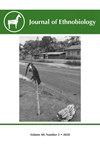远不止柴火:阿根廷农村社区家庭幸福中的木本植物
IF 1.3
3区 社会学
Q1 ANTHROPOLOGY
引用次数: 2
摘要
在世界各个农村地区使用木柴作为一种能源,对于满足人类的基本需求至关重要。然而,木柴在家庭生活中的作用及其与家庭福祉和粮食主权的联系却没有得到很好的解决。为了调查这些方面,在阿根廷的三个社会环境系统(查科、潘帕和巴塔哥尼亚)进行了民族植物学研究。收集并分析了定量和定性数据。共记录了78种木柴。木柴的主要用途是家庭取暖,其次是食物准备和烹饪,最后是生火和生火。总共有21种木柴因其各种品质和生物物理特性而受到青睐,因此具有重要的文化意义。从不同的例子和证词中,我们发现,人们和木柴之间的联系超越了纯粹的功利领域,产生了与象征、情感、情感和烹饪等方面有关的方面。这些方面有助于家庭和社区的福祉。通过这种方式,不同的木柴物种成为家庭领域的中心,不仅因为它们的燃烧能力,还因为它们在社会、文化和食物生活中的重要性。本文章由计算机程序翻译,如有差异,请以英文原文为准。
Much More Than Firewood: Woody Plants in Household Well-Being Among Rural Communities in Argentina
The use of firewood as an energetic resource in various rural regions of the world is essential for the satisfaction of basic human needs. However, the role of firewood in domestic life and its link to household well-being and food sovereignty have been poorly addressed. In order to investigate these aspects, an ethnobotanical study was carried out in three socio-environmental systems of Argentina (Chaco, Pampa, and Patagonia). Quantitative and qualitative data were gathered and analyzed. A total of 78 firewood species were recorded. The main use of firewood is for household heating, followed by food preparation and cooking, and lastly for starting and producing home fires. In total 21 firewood species are preferred over others for their various qualities and biophysical attributes, thus becoming of great cultural importance. From different examples and testimonies, we gather that the link between peoples and firewood transcends the mere utilitarian sphere, giving rise to aspects related to the symbolic, emotional, affective, and culinary, among others. These aspects contribute to the well-being of households and communities. In this way, the different firewood species become central in the domestic sphere, not only in terms of their combustion power, but also because of their importance in social, cultural and food life.
求助全文
通过发布文献求助,成功后即可免费获取论文全文。
去求助
来源期刊

Journal of Ethnobiology
Social Sciences-Anthropology
CiteScore
4.80
自引率
3.40%
发文量
21
审稿时长
>12 weeks
期刊介绍:
JoE’s readership is as wide and diverse as ethnobiology itself, with readers spanning from both the natural and social sciences. Not surprisingly, a glance at the papers published in the Journal reveals the depth and breadth of topics, extending from studies in archaeology and the origins of agriculture, to folk classification systems, to food composition, plants, birds, mammals, fungi and everything in between.
Research areas published in JoE include but are not limited to neo- and paleo-ethnobiology, zooarchaeology, ethnobotany, ethnozoology, ethnopharmacology, ethnoecology, linguistic ethnobiology, human paleoecology, and many other related fields of study within anthropology and biology, such as taxonomy, conservation biology, ethnography, political ecology, and cognitive and cultural anthropology.
JoE does not limit itself to a single perspective, approach or discipline, but seeks to represent the full spectrum and wide diversity of the field of ethnobiology, including cognitive, symbolic, linguistic, ecological, and economic aspects of human interactions with our living world. Articles that significantly advance ethnobiological theory and/or methodology are particularly welcome, as well as studies bridging across disciplines and knowledge systems. JoE does not publish uncontextualized data such as species lists; appropriate submissions must elaborate on the ethnobiological context of findings.
 求助内容:
求助内容: 应助结果提醒方式:
应助结果提醒方式:


